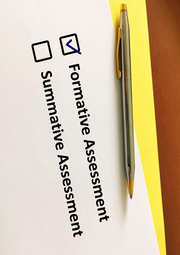The Differences between Formative Assessment and Summative Assessment
Understanding the difference between formative and summative assessment is fundamental for educators and learners alike. While both types of assessment evaluate student performance, they serve distinct purposes in the educational process.
Each focus serves a unique purpose in education and deserves close evaluation to achieve a unified goal. Together, they function as tools for teachers to ensure optimal results and empower students for growth.
Formative Assessment
Purpose: Formative assessment aims to provide ongoing feedback during the learning process. It helps educators identify areas where students excel and where they need additional support.
Timing: This type of assessment occurs throughout the learning process, allowing for adjustments and improvements along the way.
Feedback: Immediate and specific feedback is a hallmark of formative assessment. It guides students in understanding their progress and areas for improvement.
Examples: Common examples of formative assessment include quizzes, class discussions, and homework assignments.
Formative assessment plays a critical role in shaping instruction and supporting student growth. By providing timely feedback, educators can tailor their teaching methods to meet the needs of individual learners, ultimately leading to improved outcomes in the classroom.
Summative Assessment
Purpose: Summative assessment evaluates student learning at the end of a unit, semester, or school year. Its primary purpose is to measure overall achievement and assign grades or scores.
Timing: Unlike formative assessment, which occurs during the learning process, summative assessment takes place after learning is complete.
Feedback: Feedback in summative assessment is typically delayed and focuses on evaluating performance rather than guiding improvement.
Examples: Examples of summative assessment include final exams, standardized tests, and end-of-year projects.
While formative assessment informs instruction, summative assessment provides a summary of student achievement. By combining both types of assessment, educators can gain a comprehensive understanding of student progress and make informed decisions about curriculum and instruction.
Formative vs Summative Assessment: What’s the Difference?
Formative assessment focuses on guiding instruction and providing ongoing feedback, while summative assessment evaluates overall achievement at the end of a learning period.
Timing: Formative assessment takes place during learning, while summative assessment occurs after learning.
Purpose: Formative assessment aims to improve learning, while summative assessment evaluates learning outcomes.
Feedback: Formative assessment provides immediate feedback for improvement, while summative assessment offers delayed feedback focused on performance evaluation.
Examples: Formative assessment includes quizzes and discussions, while summative assessment includes final exams and standardized tests.
Understanding the key differences between formative and summative assessment is essential for educators to effectively gauge student progress and tailor instruction to meet individual needs.
Qualifications for Assessor
TAE40122 Certificate IV in Training and Assessment and TAE50122 – Diploma of Vocational Education and Training these qualifications are commonly sought by educators and trainers. These certifications equip individuals with the skills and knowledge needed to design, deliver, and assess training programs effectively. While not directly related to formative or summative assessment, they underscore the importance of assessment in vocational education settings. Educators with these qualifications are better equipped to implement both formative and summative assessment strategies to evaluate student learning effectively.
In conclusion, formative and summative assessments serve distinct purposes in education. While formative assessment supports ongoing learning and improvement, summative assessment provides a snapshot of student achievement. By utilizing both types of assessment, educators can gain valuable insights into student progress and make data-driven decisions to enhance learning outcomes.
Read how to evaluate online educational content for Advanced Placement studies.




